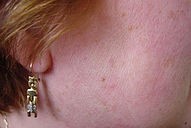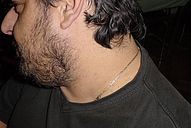
CryoPen™ is a state of the art treatment that uses extreme cold, or cryotherapy, to painlessly and safely destroy unwanted, benign and superficial lesions on the surface of the skin, such as warts, skin tags, verrucae, milia, cherry angiomas, scars, and resistant hyperpigmentation.
It has four main benefits over other treatments;
CryoPen is designed and developed by a Belgian company, HO Equipment, and distributed in the United Kingdom by Cryosthetics (CryoskinCare Ltd). (In America and Canada it is known as CryoProbe). It is used for treatments in the specialities of dermatology, podiatry, medical aesthetics and gynaecology/urology.

CryoPen uses a technology referred to as cryotherapy – ‘cryo’ meaning ‘icy cold’. This involves the use of a high pressure jet of nitrous oxide – N2O, (the source of the cold energy), which is directed at the specific lesion being treated, to within millimetre accuracy.
It is one of the leading lesion treatment devices available on the market to cosmetic practitioners. The practitioner simply points the CryoPen applicator tip directly at the lesion and applies the cryotherapy. The jet of cold treats any abnormal tissue without interfering with or damaging normal tissue in a matter of seconds.
The CryoPen device is available in various different models – CryoPen B, CryoPen M and CryoPen X which come with slightly differing applicators, and nitrous oxide cartridge capacity, but all achieve the same treatment goal.
CryoPen B
The B model comes with one applicator head for treating lesions that are between 2 and 6mms wide and a 23.5g cartridge for the nitrous oxide gas, which has 300 seconds of flow. There is a B+ upgrade available which features an additional, longer applicator head (60mm) for treating condyloma (genital or anal warts).
CyroPen M

The M model comes with two applicator tips and an 8g nitrous oxide gas cartridge.
CryoPen X
The X model, which is the premium model, allows the use of a selection of four applicators for targeting treatment of various benign lesions which are from a width of 1mm to 20mm (2 cm) or more, whilst causing no collateral damage to the surrounding, healthy skin. This model also comes with capacity for two ampoule sizes for the nitrous oxide gas, depending on the size and type of lesion being treated and the amount of cryotherapy needed for maximum gas efficiency – the practitioner can choose from either an 8g or 16g cartridge which has a 100 second or 200 second gas flow respectively. There is also a X+ upgrade available with features two additional, longer applicator heads (60mm and 120mm long) for treating condyloma.
CryoPen therapy is a medical procedure that involves the application of nitrous oxide gas ejected under high pressure on to the skin. The gas is very cold which helps to freeze and destroy any benign lesions.
During the application, the tip of the CryoPen reaches -89°C. The reason for this is to create a thermal shock at the region where the gas is pointed by causing a rapid drop in temperatures. The temperature drop has the effect of crystallising the fluid contents of the targeted cells, turning them into ice shards, resulting in the destruction of skin lesions as the membrane surrounding the treated cells is ruptured and destroyed.
The penetration of the cold is approximately 1mm per 5 seconds of treatment, so a 2mm sized lesion would take 10 seconds of nitrous oxide gas to treat.
During treatment, you may see a frost or ice-field on top of the lesion. This shouldn’t cause any worry as the frost usually goes away within a few seconds. A common technique called freeze-thaw-freeze can sometimes be used to freeze, then defrost a frozen lesion, and then freeze it again. Here, the frozen lesion is allowed to rest for 30 seconds and then a second treatment applied whereby the tissue will freeze faster second time around and destruction of the lesion is more guaranteed.
After treatment, it is advisable to leave the area uncovered as this speeds up the healing process. However, your practitioner may apply a simple dressing or plaster if there is a chance that the lesion may get rubbed or aggravated in any way.
CryoPen is classed as, and European CE mark certified, as a medical device.
The use of the CryoPen device to treat the full range of benign skin lesions can only be carried out by fully trained medical professionals and those beauty therapists or aestheticians with an NVQ4 qualification or above.
Some of the lower specification models of the device may be used by aestheticians with NVQ3 qualifications to treat a reduced range of benign lesions which they must be trained to treat, including warts, milia, skin tags, verrucae, cherry angiomas and sun/liver spots.
CryoPen treats benign skin lesions on the surface of the skin, many of which are no longer able to be treated by doctors under the NHS, due to their cosmetic nature. More complex lesions should be examined first and treated by a suitably qualified medical professional, so you may wish to speak to your GP about them first. It can treat lesions on the face, scalp and body including:
• Skin tags
• Age/liver spots
• Milia
• Cherry angioma
• Viral verrucae (warts)
• Solar lentigo (sun spots)
• Other pigmentation
• Plantar warts
• Condyloma (genital or anal warts)
• Popular nevi (moles, birthmarks etc)
• Contagiosum (water warts)
• Hyperplasia
Treatment is safe for all (including children and young adults, although you will need to check if the clinic is insured to treat minors).
Clinical data shows that the results are permanent after one or two treatments. Some types of skin lesions may return in other places if you are prone to such manifestations.
CryoPen therapy has been established to be very safe. However, be prepared for the following:
• Slight discomfort during the procedure - As with most lesion treatments, you’ll feel some slight discomfort while CryoPen is being applied. The discomfort usually feels like the pressure of a pen being pressed against your skin. However, unless you have a problem such as a skin allergy, it will only last a few seconds. Generally, no topical anaesthesia (or numbing cream) is required before treatment.
• Mild stinging following the procedure - Immediately after the procedure, you will likely experience mild to medium stinging that may last for several minutes to an hour. Again, don’t be too worried about the stinging as it goes away naturally.
• Sores and blisters - Rarely, the skin where the lesion was treated, usually becomes sore, red, weepy and blistered. It may sting for an hour or so after treatment. Often a scab will form in the following days. This is common where deep freezing is used and may cause pain immediately after the treatment. The practitioner may recommend topical or oral pain killers to relieve discomfort if required. It is important not to scratch or pick at a scab as this can lead to scarring.
The treated lesions should completely heal within 1 to 4 weeks and scabs formed around the lesion will shed after a week to 10 days. Lesions on the leg take the longest time to heal. Some people may develop a temporary change in skin colour (pigmentation) or slight scarring in the treated area – pigment change is more common in darker skin types and may not be temporary.
Hair follicles can be damaged by cryotherapy so if the lesion is within an area of hair, such as on the scalp, then a small amount of hair loss may occur.
Rarely there is potential for superficial nerve damage, depending on the location of the treated lesion. This may cause a temporary feeling of numbness or tingling in the area which may last for a few months.
If a treated lesion does not heal as expected, or there is pain or redness after a few days, then you should contact the practitioner again as these could be signs of an infection.
Anyone who is otherwise healthy can comfortably undergo a CryoPen treatment.
However, there are a few special cases:
• Firstly, it is essential that correct diagnosis of a lesion is carried out before treatment because some lesions can be related to cancer and it is quite easy to confuse these with ordinary, benign lesions. So, the expert advice of a doctor or dermatologist is needed as CryoPen cannot be used to treat cancerous lesions. If you are concerned about a lesion, or it has changed in any way recently, please speak to your GP as a first port of call.
• Secondly, CryoPen may not be used if the lesions are too close to delicate structures of the body such as the eyes.
Treatment will not be advised for pregnant women or breastfeeding mothers, as the risks are unknown, and you will be advised to wait until after this period of time in your life before having treatment.
How long you need to apply the treatment before seeing results often depends on the size and nature of the lesion. However, for a normal, superficial, benign lesion, it only takes 2 to 10 seconds to complete the treatment procedure in one session. Results are usually observable within1 to 6 weeks of treatment.
4 weeks following treatment, a follow-up appointment is usually recommended to assess the response to treatment so the practitioner can determine if there is a need for additional treatments to completely remove any remaining lesions or parts of the lesion. In some cases, one treatment will suffice and no follow-up is required for small, simple lesions.
However, if the lesion is too persistent and doesn’t go away following the initial treatment, a second treatment can be done. This second treatment should be done within 1 to 4 weeks of the first one.
Most benign lesions are treated with CryoPen for just £50, even if there are multiple, small lesions. If you have more than one similar lesion which is to be treated, then you may be charged an extra £25+, depending on the number and size of all the lesions and the treatment time needed. For example, warts and verrucas usually cost around £80.
These photos are real patients; your results may differ.


Treatment of seborrheic keratosis: left - before and right – after 4 weeks


Treatment of wart on eyelid: left - before and right – after 4 weeks


Treatment of pigmented spot on cheek: left - before and right – after 3 weeks


Treatment of hemangioma: left - before and right – after 6 weeks
Photos courtesy of Dr Zois and Ho Equipments.
Video demonstrating the treatment of milia using the CryoPen
Do you have a question? Ask one of our experts NOW